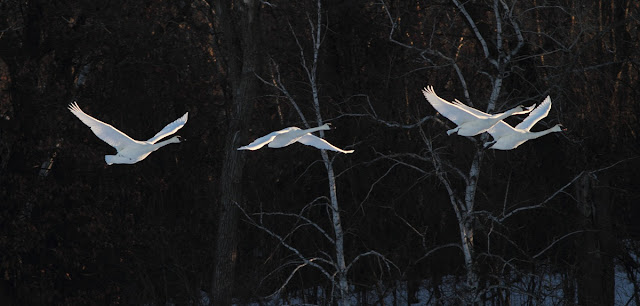What It Takes to See It 6 January 2013
A million tiny stars scattered across a perfectly
black sky this morning, and a tipsy crescent moon hung in the midst of the last
parting mists of the sky. As much as the
moon was waning, the wispy moon doggy was losing its grip to an icy clear
morning. The deep cold felt good,
familiar, crisp. It was a long time before sunrise. I headed to a familiar patch
of open water with high hopes for a morning with Trumpeter Swans.
The sun rose slowly, and, as we arrived, the birds were in open water, conserving energy the best they could. We studied the light for a long time, waiting for something to happen. Only eleven swans of the previous visit’s thirty-eight occupied these waters, so I assumed the morning would bring arrivals, inbound flights with exciting landings.
The light was another old friend, but, today, in the complete absence of cloud cover of any sort, the light was a little ornery, a difficult partner in the pursuit of imagery. As the light grew warmer, we could hear the distant bugles of departing swans, the slapping of big, webbed feet on the water, the jumbled flight calls resonating and bouncing off of one another. Small sorties lifted off, each heading our way. Anxiously, Bruce and I began sharing what we each knew of this cantankerous light. Meter. Check. Re-check. Meter. Focus. Brace. Compose. Photograph!
Cold fingers, athletic reflexes, a wealth of knowledge about our favorite swans’ usual patterns, and good dose of luck soon placed the arriving swans squarely in front of us, splashing down just a few feet away. Our cameras sprang to life, celebrating the spectacular moments we share with this wild beauty. The swans bustled with newly found energy as the arrivals greeted those already here. Old friends.
What does it take to see a part of nature? What does it mean to see it? To see it, really see it, one must come to know it. This takes time, dedication, and more. To know it, one must
feel. To see, as a photographer, is to
search for the image that feels, the image that shares the feelings within. I really love these swans. I have worked hard to know them. It is that feeling, that love of nature, that
drives the photographer's vision. Seeing runs deeply. Sharing the vision is even harder. I never know for sure if I've come close.
I
photographed these old friends with a refurbished Canon 7D and reliable prime
300mm f4 IS Canon fluorite lens. The light
was very unusual, and it proved very difficult to make an exposure. Most image exposures were made by focusing on
the northern horizon and setting a manual exposure based on that average
reading. Check out some of Bruce’s artwork at www.bruceleventhal.blogspot.com





.jpg)

















exquisite photos, Brian. Thank you for sharing your visit with your old friends.
ReplyDelete